Facilities: Difference between revisions
(Initial Import of Facilities page) |
m (→FrontX: Added link to image) |
||
| (43 intermediate revisions by 2 users not shown) | |||
| Line 1: | Line 1: | ||
CSU-CHILL is spread across multiple sites, and comprises a number of weather radar systems, laboratory and workshop space. | |||
=CSU-CHILL= | ==Weather Radars== | ||
CSU-CHILL | ===[[CSU-CHILL S- and X-band|CSU-CHILL]]=== | ||
[[Image:CHILL Radome.jpg|x200px|left|thumb|The CSU-CHILL Radar |link=CSU-CHILL S- and X-band]] | |||
{{#lst:CSU-CHILL S- and X-band|overview}} | |||
<br clear=all> | |||
===[[Sea-Pol|CSU Sea-Pol]]=== | |||
[[Image:Sea pol small.jpg|x300px|left|thumb|The CSU Sea-Pol Radar|link=Sea-Pol]] | |||
{{#lst:Sea-Pol|overview}} | |||
[[Image: | <br clear=all> | ||
===[[CSU-CHIVO]]=== | |||
[[Image:CHIVO ardec.jpg|x200px|left|thumb|The CSU-CHIVO Radar|link=CSU-CHIVO]] | |||
{{#lst:CSU-CHIVO|overview}} | |||
[[ | <br clear=all> | ||
===SPLASH/SAIL=== | |||
This is a pair of [[X-band containerized radar|X-band containerized radars]] designed for rapid deployment to remote locations. They feature 25 kW magnetron transmitters, with 1.6m antennas (1.3° beamwidth). | |||
The | <br clear=all> | ||
===Miami W-band=== | |||
The [[Miami W-band]] radar is a vertically-pointing, containerized W-band cloud radar system, operated along with the [https://psl.noaa.gov/ NOAA Physical Science Laboratory]. It has a 1.2 kW Extended Interaction Klystron (EIK) transmitter. It has a number of antenna options, including 0.9m (0.25° beamwidth). | |||
[[ | <br clear=all> | ||
===PSL W-band=== | |||
The [[PSL W-band]] radar is a vertically-pointing, containerized W-band cloud radar system, operated along with the [https://psl.noaa.gov/ NOAA Physical Science Laboratory]. It has a 1.2 kW Extended Interaction Klystron (EIK) transmitter. It has a 0.3m (1° beamwidth) antenna, and is designed for deployment on NOAA P3 research aircraft. | |||
[[ | <br clear=all> | ||
===CSU/NASA D3R=== | |||
[[CSU/NASA D3R]] is a dual-wavelength Ku- and Ka-band radar featuring solid-state transmitters and pulse compression receivers. It is trailer-mounted for ease of transportation. It is based at the [https://www.nasa.gov/wallops/ NASA Wallops Flight Facility]. | |||
== | <br clear=all> | ||
===[[FrontX]]=== | |||
[[Image:Frontx small.jpg|x250px|left|thumb|FrontX Radar|link=FrontX]] | |||
{{#lst:FrontX|overview}} | |||
= | <br clear=all> | ||
[[Image: | [[Image:Pawnee_Radar.jpg|right|200px||link=CSU Pawnee S-band]] | ||
===[[CSU Pawnee S-band]]=== | |||
{{#lst:CSU Pawnee S-band|overview}} | |||
==Locations== | |||
CSU-CHILL currently administers two permanent sites in Colorado | |||
* [[CSU-CHILL main site]], Greeley CO | |||
* [[ARDEC South radar site]], Fort Collins CO | |||
= | ==Lab Facilities== | ||
In addition to the radar and remote sensing equipment, the CSU-CHILL facility also hosts an [[RF Instrument Lab]], which is used by both CHILL staff as well as CSU students during construction and maintenance of the radar equipment. | |||
The | The CHILL main site includes a workshop with a variety of tooling and hardware. | ||
== | |||
==Electronic Design and CAD Software== | |||
CSU-CHILL has licenses for several electronic design automation (EDA) and computer aided design (CAD) packages, including: | |||
* MathWorks Matlab | |||
* Keysight Advanced Design System (ADS) | |||
* Keysight Genesys | |||
* Keysight SystemVue | |||
* Altium Designer | |||
* Solidworks | |||
* Xilinx Vivado and ISE | |||
In addition, students at CSU-CHILL have access to software offered by the CSU Electrical and Computer Engineering department. | |||
Latest revision as of 17:54, 6 February 2024
CSU-CHILL is spread across multiple sites, and comprises a number of weather radar systems, laboratory and workshop space.
Weather Radars
CSU-CHILL
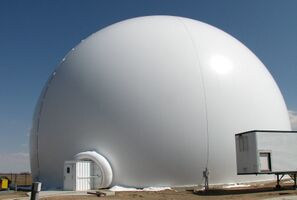
CSU-CHILL S- and X-band is a dual-wavelength S- and X-band, dual polarization scanning radar system located at the CSU-CHILL main site. The S-band transmitter can be selected between dual 1 MW Klystron transmitters or solid-state 24 kW transmitters. The X-band transmitter is a 25 kW magnetron. The antenna is an 8.5m dual-offset (1° at S-band, 0.3° at X-band).
The radar in its current form is designed to provide very high purity polarimetric data thanks to its unique offset-feed antenna design. The dual-wavelength capability with S- and X-band simultaneous operation is unique in the research radar community. The radar offers high spatial resolution at X-band thanks to the combination of short wavelength and large aperture antenna.
The radar site is located at the CSU-CHILL main site in Greeley, CO.
CSU Sea-Pol
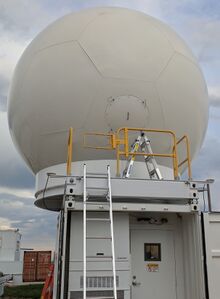
The CSU Sea-Pol ship- and land-deployable radar measures dual-polarization data over a range in excess of 200 km. It is designed for operation aboard Global-class research ships operated by the US oceanographic community, and has also been successfully operated on land-based deployments. The radar operates at C-band (5.65 GHz) and has a 4.3m stabilized antenna system.
The radar features dynamic platform stabilization, allowing it to perform earth-relative scanning strategies even on a moving platform such as a ship on the open ocean. A state of the art RVP900 digital signal processor outputs dual-polarization moment data, and provides the IRIS radar user interface.
The radar is packaged into two sub-assemblies, the radar shelter and the antenna platform. The radar shelter is housed in a 20' ISO container for ease of transportation and mounting onto research ships. The antenna platform is designed to mate to the top of the radar shelter, and holds the antenna positioner, antenna and radome.
CSU Sea-Pol is a part of the National Science Foundation's Community Instruments and Facilities Program, and may be requested through that program. When not deployed in the field, the radar is based at the CSU-CHILL main site in Greeley CO.
CSU-CHIVO
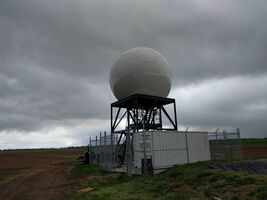
CSU-CHIVO is a C-band radar system with a 250 kW magnetron transmitter and a 4.5m (1° beamwidth) antenna. The antenna and radome are on top of a 6.5m (20 ft) steel tower to raise it above surrounding ground clutter. It is packaged in a containerized format for ease of transportation.
The radar is based on the Vaisala WRM200 commercial weather radar system. It is normally based at the ARDEC South radar site near Fort Collins, CO where it supports research scientists at Colorado State University. In 2019, it was used by the National Weather Service office in Boulder, CO as a gap-filler during an extended servicing of the NWS Denver NEXRAD (KFTG). The radar has been deployed several times in support of field campaigns as well.
SPLASH/SAIL
This is a pair of X-band containerized radars designed for rapid deployment to remote locations. They feature 25 kW magnetron transmitters, with 1.6m antennas (1.3° beamwidth).
Miami W-band
The Miami W-band radar is a vertically-pointing, containerized W-band cloud radar system, operated along with the NOAA Physical Science Laboratory. It has a 1.2 kW Extended Interaction Klystron (EIK) transmitter. It has a number of antenna options, including 0.9m (0.25° beamwidth).
PSL W-band
The PSL W-band radar is a vertically-pointing, containerized W-band cloud radar system, operated along with the NOAA Physical Science Laboratory. It has a 1.2 kW Extended Interaction Klystron (EIK) transmitter. It has a 0.3m (1° beamwidth) antenna, and is designed for deployment on NOAA P3 research aircraft.
CSU/NASA D3R
CSU/NASA D3R is a dual-wavelength Ku- and Ka-band radar featuring solid-state transmitters and pulse compression receivers. It is trailer-mounted for ease of transportation. It is based at the NASA Wallops Flight Facility.
FrontX
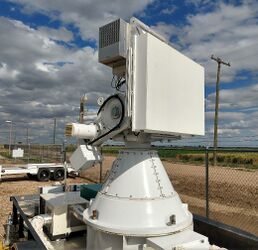
Front-X is an X-band dual-polarization phased array radar demonstrator radar. The objective of this radar system is to demonstrate dual-polarization capability and to study the limits of phased array antennas on polarization measurements. The radar is a test-bed to validate new radar waveforms, pulsing schemes, signal processing algorithms and scanning strategies that take advantage of electronic beam steering. The radar was developed in partnership with FirstRF corp.
The radar consists of an X-band dual-polarization active phased array antenna that generates a fixed beam in one axis and can scan electronically in the other axis. The antenna array is composed of 64 radiating elements, each driving a patch array antenna that develops a fixed pattern 2.6° wide. Beam width is 1.5°x2.6°, with over 90° electronic scan range. Transmit peak power is 70 W, with a duty cycle up to 33%. Antenna polarization is switched between horizontal and vertical on an alternating basis. The antenna instantaneous bandwidth is 30 MHz tunable over the 9.21 - 9.61 GHz frequency range.
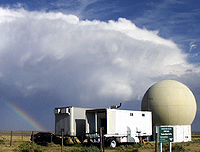
CSU Pawnee S-band
The CSU-Pawnee Doppler radar was a single-polarization S-band radar system, with a Klystron transmitter. It was decomissioned in March 2015. It was located 48 km NNW of the CSU-CHILL radar. The radar system was used in a dual-doppler configuration along with CSU-CHILL, and performed synchronized scans.
Locations
CSU-CHILL currently administers two permanent sites in Colorado
- CSU-CHILL main site, Greeley CO
- ARDEC South radar site, Fort Collins CO
Lab Facilities
In addition to the radar and remote sensing equipment, the CSU-CHILL facility also hosts an RF Instrument Lab, which is used by both CHILL staff as well as CSU students during construction and maintenance of the radar equipment.
The CHILL main site includes a workshop with a variety of tooling and hardware.
Electronic Design and CAD Software
CSU-CHILL has licenses for several electronic design automation (EDA) and computer aided design (CAD) packages, including:
- MathWorks Matlab
- Keysight Advanced Design System (ADS)
- Keysight Genesys
- Keysight SystemVue
- Altium Designer
- Solidworks
- Xilinx Vivado and ISE
In addition, students at CSU-CHILL have access to software offered by the CSU Electrical and Computer Engineering department.